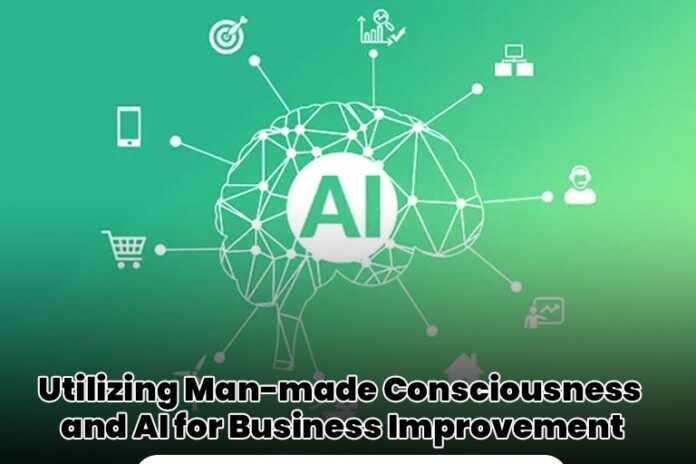In the present quick-moving and information-driven business scene, remaining serious expects associations to consistently look for ways of upgrading their tasks and dynamic cycles. Man-made brainpower (simulated intelligence) and AI (ML) have arisen as useful assets that empower organizations to open significant experiences from their information, mechanize monotonous errands, and go with informed choices. By utilizing simulated intelligence and ML advancements, associations can accomplish huge enhancements in effectiveness, efficiency, and productivity. In this article, we will investigate the different manners by which organizations can use man-made intelligence and ML for streamlining and gaining an upper hand on the lookout.
- Data-driven Navigation:
Simulated intelligence and ML calculations can dissect tremendous measures of organized and unstructured information, extricating significant examples and patterns. By bridging these abilities, associations can go with information-driven choices that depend on precise and convenient experiences. Whether it’s estimating requests, distinguishing market drifts, or anticipating client conduct, artificial intelligence, and ML models can give important data that engages organizations to improve their procedures, smooth out activities, and remain in front of the opposition.
- Process Robotization:
Robotization is a vital driver of business streamlining, permitting associations to decrease costs, further develop effectiveness, and limit blunders. Artificial intelligence and ML calculations can be prepared to computerize redundant errands, for example, information passage, report handling, and client care. By appointing these unremarkable assignments to simulated intelligence-controlled frameworks, organizations can let loose important HR to zero in on additional complicated and vital exercises. In addition, computer-based intelligence-empowered process mechanization can prompt upgraded exactness and quicker times required to circle back, bringing about superior consumer loyalty and expanded functional proficiency.
- Customer Personalization:
Conveying customized encounters with clients has become pivotal for organizations across enterprises. Simulated intelligence and ML calculations can investigate immense measures of client information, including buy history, perusing conduct, and segment data, to make profoundly designated and customized proposals. By understanding individual client inclinations and necessities, associations can upgrade their showcasing efforts, tailor item contributions, and further develop consumer loyalty and standards for dependability. Computer-based intelligence-fueled chatbots and remote helpers additionally empower organizations to give nonstop client service, tending to questions and settling issues progressively.
- Supply Chain Enhancement:
A proficient production network on the board is basic for organizations to fulfill client needs while limiting expenses and stock levels. Artificial intelligence and ML calculations can enhance production network processes by examining verifiable information, anticipating request changes, advancing stock levels, and recognizing possible bottlenecks or interruptions. By utilizing computer-based intelligence and ML for inventory network advancement, associations can further develop anticipating exactness, smooth out acquirement, and coordinated factors tasks, diminish wastage, and guarantee ideal conveyance of items and administrations.
- Risk Administration:
Man-made intelligence and ML methods can be instrumental in distinguishing and alleviating gambles with that organizations face. By investigating authentic information and ongoing data, these advances can distinguish designs that demonstrate expected dangers or irregularities. Whether it’s extortion recognition, network protection, or credit risk appraisal, artificial intelligence-controlled calculations can rapidly recognize dubious exercises, making organizations aware of possible dangers and empowering proactive gambling on the board. By utilizing computer-based intelligence and ML for risk moderation, associations can safeguard their resources, improve consistency, and shield their standing.
- Predictive Investigation:
Simulated intelligence and ML strategies succeed at prescient examination, empowering organizations to expect future results in light of authentic information. By dissecting examples and patterns, associations can make exact expectations concerning advertising patterns, client conduct, and business execution. This data can be utilized to enhance evaluating methodologies, stock administration, and asset assignment. By utilizing prescient examination, organizations can go with proactive choices, limit gambles, and profit by arising valuable open doors.
- Enhanced Client Bits of knowledge:
Artificial intelligence and ML calculations can dive profound into client information to reveal significant bits of knowledge that go past straightforward division. By applying progressed investigation to client information, organizations can acquire a more profound comprehension of client inclinations, ways of behaving and feeling examination. This data can be utilized to make exceptionally designated promoting efforts, foster customized items and administrations, and further develop generally speaking client experience. The capacity to comprehend clients at a granular level permits organizations to improve their contributions and construct long-haul client reliability.
- Continuous Learning and Improvement:
One of the critical benefits of man-made intelligence and ML advances is their capacity to learn and further develop after some time persistently. As additional information is taken care of in the framework, calculations can refine their models, adjust to evolving patterns, and improve their precision. This iterative educational experience permits organizations to streamline their activities, adjust to advancing business sector elements, and remain in front of contenders. By utilizing simulated intelligence and ML for nonstop learning, associations can make steady upgrades, drive development, and accomplish supportable development.
- Human Asset The executives:
Simulated intelligence and ML innovations can likewise be used for improving human assets in the executive’s processes. For example, man-made intelligence-controlled enrollment frameworks can dissect resumes, distinguish important abilities, and waitlist competitors in light of predefined models. ML calculations can anticipate worker weakening and help organizations proactively address maintenance challenges. Simulated intelligence chatbots and remote helpers can smooth out worker onboarding and give moment admittance to HR-related data, lessening authoritative weights. By utilizing man-made intelligence and ML for human assets the board, and associations can upgrade labor force efficiency, further develop representative commitment, and encourage a positive workplace.
- Competitive Benefit and Market Separation:
In the present hyper-cutthroat business scene, acquiring an upper hand is significant for long-haul achievement. Artificial intelligence and ML furnish associations with the devices to separate themselves from contenders. By utilizing these innovations, organizations can enhance their cycles, convey customized encounters, pursue information-driven choices, and adjust rapidly to changing economic situations. The capacity to saddle man-made intelligence and ML really can turn into a one-of-a-kind selling recommendation, drawing in clients who esteem development, proficiency, and custom-made arrangements.
- Enhanced Item Advancement:
Artificial intelligence and ML advancements can fundamentally affect item improvement processes. By dissecting market patterns, client criticism, and contender experiences, organizations can recognize holes on the lookout and pursue information-driven choices while planning and sending off new items or administrations. Artificial intelligence-controlled calculations can help with recognizing client inclinations, leading feeling investigation, and foreseeing item execution. This empowers organizations to streamline their item improvement procedures, diminish time to market, and increment the odds of coming out on top by adjusting contributions to client needs.
Conclusion:
The incorporation of simulated intelligence and ML innovations offers organizations a great many open doors for improvement across different regions. From information-driven navigation and cycle computerization to client personalization and store network streamlining, simulated intelligence and ML empower associations to open important bits of knowledge, further develop productivity, and gain an upper hand. By embracing these advancements and utilizing their abilities, organizations can improve their activities, upgrade client encounters, and drive supportable development in the dynamic and advancing business scene.
Read more – The Climb of Advanced monetary standards: Open Entryways and Risks for Monetary Sponsor
Read more – Adjusting Work and Life: Techniques for Accomplishing Work-Life Coordination in the Business World



